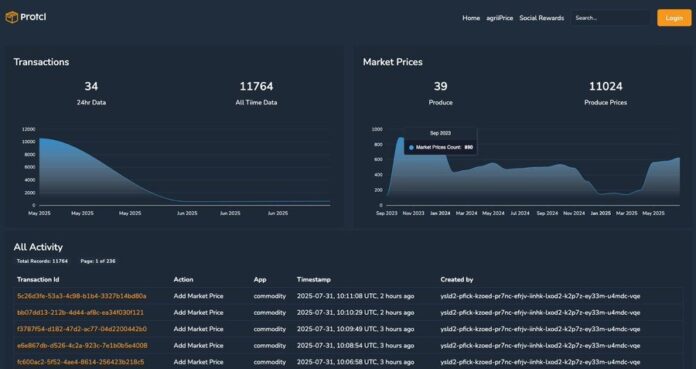AgriiDAO has passed the 11,000 mark for fresh produce prices captured and stored through its on-chain tool, agriiPrice. The project, which focuses on bringing real-time agricultural pricing onto the blockchain, has been steadily collecting verified market data from across South Africa’s fresh produce network. Every data point is verified by human agents on the ground, logged through agriiDAO’s app, and stored permanently on Protcl.
The latest milestone reflects growing activity inside agriiDAO’s ecosystem, which relies on a blend of on-chain tools and local partnerships. While many blockchain projects focus on abstract metrics or synthetic assets, agriiDAO deals with physical goods whose prices affect livelihoods. That grounding gives the project a slightly different flavour from the broader Web3 trend towards AI models and token speculation. Here, the focus is potatoes, carrots, onions, tomatoes and other everyday market staples.
Each price logged on agriiPrice is tied to a specific location and time, with verification handled by agents physically present in the market. That ensures the prices reflect what traders are actually seeing on the ground, not remote estimates or scraped figures. Once logged, the data is stored permanently on Protcl, a decentralised storage layer that works alongside the Internet Computer. The aim is to keep the pricing records both tamper-proof and publicly accessible, with the records remaining on-chain long after the market day is done.
Access to agriiPrice data comes through the $AGRII token, while $PROTCL represents the storage layer and $ICP powers the computational backend. This setup ties the system to a broader on-chain infrastructure that’s already being used across the Internet Computer ecosystem. Each layer does a distinct job, and together they support the flow from local agent to global archive.
What makes this milestone notable is not just the number, but the context. Capturing over 11,000 verified data points from fresh produce markets is labour-intensive. Markets shift quickly, prices are volatile, and mobile agents need to log prices accurately under time pressure. The result, though, is a growing database of agricultural prices that anyone with access rights can analyse, monitor or build upon.
Projects like this often attract a small but focused user base. It’s unlikely to go viral on social media, but for buyers, sellers, cooperatives and agricultural analysts, the information is practical and immediately relevant. Over time, having a public record of historical produce prices could support better decision-making, more stable contracts and even more informed policy.
There are still challenges, of course. Data collection relies on agents showing up every day and inputting clean figures. Network outages, human error or skipped market days could affect the consistency of the feed. But so far, the system appears to be functioning, and the milestone of 11,000 entries suggests that the model is holding up under real-world pressure.
What happens next may depend on whether others choose to plug into the agriiDAO feed. Developers could integrate the data into their own apps, dashboards or pricing models. Market agents might find incentives to contribute more regularly if demand for the data increases. And agricultural groups might start using it as a reference point for contracts or claims.
For now, though, agriiDAO is keeping its pace. Verified prices come in from South African markets, get processed through agriiPrice and are logged permanently on Protcl. It’s a loop that seems to be working. The 11,000 price points logged so far are publicly verifiable and tied to real-world activity. That alone gives them a weight that abstract tokens and theoretical yields rarely match.
The project continues to evolve, with updates expected as usage grows and new markets come online. For now, agriiDAO’s approach offers a working example of how Web3 infrastructure can meet agricultural needs without turning the process into a branding exercise. It’s just market data, logged by people, stored by code, and available for those who need it.
Dear Reader,
Ledger Life is an independent platform dedicated to covering the Internet Computer (ICP) ecosystem and beyond. We focus on real stories, builder updates, project launches, and the quiet innovations that often get missed.
We’re not backed by sponsors. We rely on readers like you.
If you find value in what we publish—whether it’s deep dives into dApps, explainers on decentralised tech, or just keeping track of what’s moving in Web3—please consider making a donation. It helps us cover costs, stay consistent, and remain truly independent.
Your support goes a long way.
🧠 ICP Principal: ins6i-d53ug-zxmgh-qvum3-r3pvl-ufcvu-bdyon-ovzdy-d26k3-lgq2v-3qe
🧾 ICP Address: f8deb966878f8b83204b251d5d799e0345ea72b8e62e8cf9da8d8830e1b3b05f
🪙 BTC Wallet: bc1pp5kuez9r2atdmrp4jmu6fxersny4uhnaxyrxau4dg7365je8sy2q9zff6p
Every contribution helps keep the lights on, the stories flowing, and the crypto clutter out.
Thank you for reading, sharing, and being part of this experiment in decentralised media.
—Team Ledger Life


